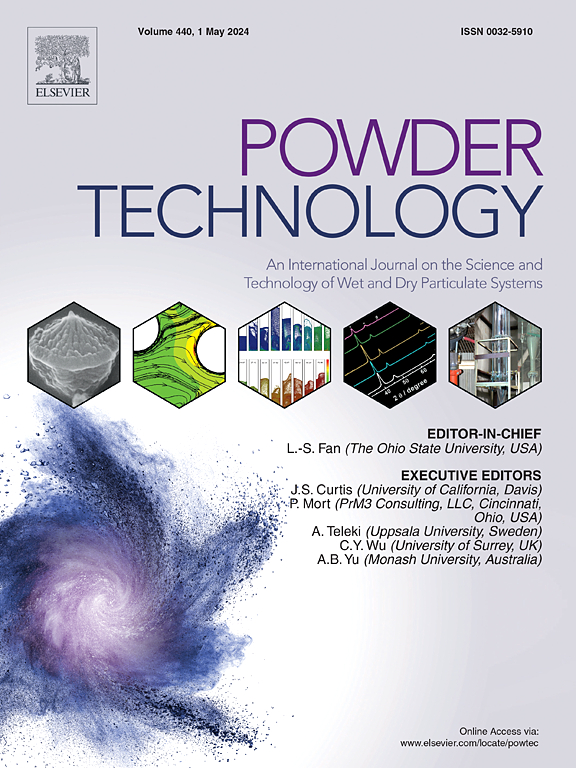GPU-DEM study of the flow and energy dissipation behaviors of burden materials in a full bell-less blast furnace charging system
IF 4.5
2区 工程技术
Q2 ENGINEERING, CHEMICAL
引用次数: 0
Abstract
The blast furnace bell-less top charging system involves multiple handling steps that affect burden distribution in the furnace throat. This study employs a GPU-DEM model to analyze particle motion and energy dissipation of burden materials from the belt conveyor to the furnace throat, providing insights into flow behavior, segregation, degradation, and erosion. Particle properties and size distributions strongly affect the flow structure. Pellets exhibit higher velocities than lumps, sinters, and coke, with differences decreasing in the rotating chute. Four regions of high energy dissipation were found, with coke and sinter degradation reaching 15 % of the feed and lump and pellet degradation remaining around 1 %. Wear intensifies with broader particle size distributions, driven by shear energy. Segregation before hopper filling is minimal, but in-hopper segregation significantly impacts in-furnace segregation, where larger particles accumulate at the periphery and top. Heap formation arises mainly from shifts between rolling and impact energy dissipation.

基于GPU-DEM的全无钟高炉装料系统物料流动及能量耗散特性研究
高炉无钟顶装料系统涉及多个处理步骤,影响炉膛内的炉料分布。本研究采用GPU-DEM模型分析了物料从带式输送机到炉喉的颗粒运动和能量耗散,从而深入了解了物料的流动行为、偏析、降解和侵蚀。颗粒性质和粒径分布对流动结构有很大影响。球团比团块、烧结矿和焦炭表现出更高的速度,在旋转溜槽中差异减小。发现了四个高能量耗散区域,焦炭和烧结矿的降解达到了饲料的15%,块状和球团的降解保持在1%左右。在剪切能的驱动下,磨损随粒径分布的扩大而加剧。料斗填充前的偏析最小,但料斗内偏析显著影响炉内偏析,较大的颗粒积聚在外围和顶部。堆的形成主要是由于滚动和冲击能量消耗之间的转换。
本文章由计算机程序翻译,如有差异,请以英文原文为准。
求助全文
约1分钟内获得全文
求助全文
来源期刊

Powder Technology
工程技术-工程:化工
CiteScore
9.90
自引率
15.40%
发文量
1047
审稿时长
46 days
期刊介绍:
Powder Technology is an International Journal on the Science and Technology of Wet and Dry Particulate Systems. Powder Technology publishes papers on all aspects of the formation of particles and their characterisation and on the study of systems containing particulate solids. No limitation is imposed on the size of the particles, which may range from nanometre scale, as in pigments or aerosols, to that of mined or quarried materials. The following list of topics is not intended to be comprehensive, but rather to indicate typical subjects which fall within the scope of the journal's interests:
Formation and synthesis of particles by precipitation and other methods.
Modification of particles by agglomeration, coating, comminution and attrition.
Characterisation of the size, shape, surface area, pore structure and strength of particles and agglomerates (including the origins and effects of inter particle forces).
Packing, failure, flow and permeability of assemblies of particles.
Particle-particle interactions and suspension rheology.
Handling and processing operations such as slurry flow, fluidization, pneumatic conveying.
Interactions between particles and their environment, including delivery of particulate products to the body.
Applications of particle technology in production of pharmaceuticals, chemicals, foods, pigments, structural, and functional materials and in environmental and energy related matters.
For materials-oriented contributions we are looking for articles revealing the effect of particle/powder characteristics (size, morphology and composition, in that order) on material performance or functionality and, ideally, comparison to any industrial standard.
 求助内容:
求助内容: 应助结果提醒方式:
应助结果提醒方式:


